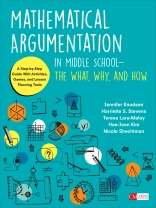Get them talking: Your formula for bringing math concepts to life!
Want your middle schoolers to intelligently engage with mathematical ideas? Ready to help them construct and critique viable arguments that meet tough Standards for Mathematical Practice 3 standards? Look no further. This research-based gem will help you foster the critical reasoning and argumentation skills every student needs for intelligent discourse within our modern society. Learn how to bring mathematical argumentation alive in your classroom—all within a thoroughly explained four-part model that covers generating cases, conjecturing, justifying, and concluding.
Filled with content-focused and classroom-ready games, activities, vignettes, sample tasks, and links to online tools and a rich companion website, this innovative guide will help you
- Immediately engage students in fun, classroom-ready argumentation activities
- Plan lessons that foster lively, content-driven, viable argumentation
- Help students explore mathematical ideas and take ownership of their learning
- Facilitate deep mathematical understanding
- Promote students’ precise use of mathematical language to construct, justify, and critique mathematical ideas and mathematical statements or the arguments of others.
- Encourage logical, clear connections between abstract ideas for enhanced 21st century skills
This guide delivers all the tools you need to get serious about mathematical argumentation and bring well-planned, well-constructed mathematical discourse to life in your classroom today!
Mục lục
Preface
Acknowledgments
About the Authors
Chapter 1. Mathematical Argumentation: Why and What
Argumentation Is Important!
What Argumentation Is—and Is Not
A Four-Part Model of Argumentation
About Truth
Teaching as Disciplined Improvisation
Improvisation for Argumentation and Norm Setting
Sharing Mathematical Authority
Getting Started With Argumentation
Argumentation Lessons Versus Argumentation in Lessons
Working Together
Chapter 2. Generating Cases
What Does It Mean to Generate Cases?
An Activity Rich in Argumentation and Content
Vignette: Small Groups Generate Cases
Teaching Moves
Establishing Norms
Planning
Tasks
Working Together
Chapter 3. Conjecturing
What Does It Mean to Conjecture?
Vignette: Conjecturing Together
Teaching Moves
Establishing Norms
Planning
Tasks
Working Together
Chapter 4. Justifying
What Does It Mean to Justify?
Vignette: Justifying Multiple Conjectures
Teaching Moves for Eliciting Justifications
Vignette: Critiquing and Connecting Arguments
Teaching Moves for Critiquing and Connecting Arguments
Establishing Norms
Planning
Tasks
Working Together
Chapter 5. Representations in Justifications
What Are Representations?
Vignette: Visual Representations Foster Participation
Vignette: Gestures Enable a Unique Contribution
Teaching Moves
Using Dynamic Digital Tools
Establishing Norms
Planning
Tasks
Working Together
Chapter 6. Levels of Justification
Four Levels of Justification
Level 0: No Justification
Level 1: Case-Based Justifications
Level 2: Partially Generalized Justifications Based on Cases
Level 3: Fully Generalized Justifications
A Rubric for Levels
Teaching Moves for Transitions Between Levels
Working Together
Chapter 7. Concluding
What Does It Mean to Conclude?
Vignettes: Concluding
Teaching Moves
Establishing Norms
Planning
Tasks
Working Together
Chapter 8. Planning
How Can You Plan for Students’ Argumentation?
Written Lesson Plans
Visualizing a Lesson
Vignette: Visualizing Justification
Digital Tools
Updating and Sharing Lesson Plans
Advice on Planning
Working Together
Glossary
References
Index
Giới thiệu về tác giả
Nicole Shechtman, Ph.D., is a senior educational researcher at SRI International located in Menlo Park, CA. Her research and evaluation work explores critical issues in mathematics teaching and learning, innovative uses of educational technology, and the development of social and emotional competencies, such as effective communication, teamwork, and everyday problem-solving. She holds a Ph D in psychology from Stanford University.












